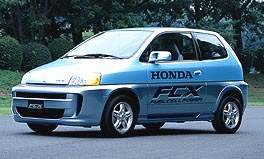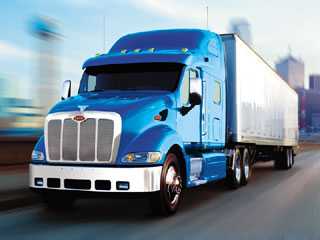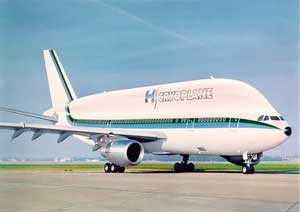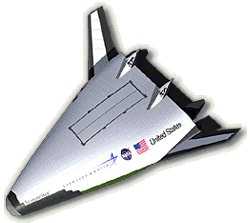Hydrogen Powered Vehicles
Automobiles, trucks, airplanes, and even rockets can
be hydrogen fueled.
Hydrogen Powered Cars and Trucks

Ford Motor Company recently
introduced the P2000, a new car with a hydrogen internal combustion engine
(ICE) that "could help bridge the gap between gasoline vehicles and
the fuel cell vehicles of the future." [1]
The engine is not much different from an ordinary gasoline engine. The use
of hydrogen greatly reduces emissions although nitrous oxides are still a
problem. Engine efficiency about equals a diesel, about 35%. The hydrogen
is stored in a tank that is rated at 240 atmospheres (240 bars). The range
is only 62 miles. Ford does not give the price of the P2000, but it should
be inexpensive given that all of the components are rather ordinary.
 Honda
has introduced the FCX, a car utilizing a fuel cell instead of an ICE. [3]
This gives an overall efficiency of 45%. A fuel cell turns hydrogen into
electricity which drives the wheels through electric motors. The hydrogen
is stored in carbon fiber tanks at 333 bars. This gives the FCX a range of
150 miles. The fuel cells provide only the average power. Super capacitors
provide extra power during acceleration and hill climbing. The tanks, the
fuel cell, the super capacitors, etc. take up 4 times more space compared
to a conventional design. There is not much room left for passengers and
cargo. The FCX costs 3 million
dollars, but Honda leases them for $500 per month to the state of
California. Honda
has introduced the FCX, a car utilizing a fuel cell instead of an ICE. [3]
This gives an overall efficiency of 45%. A fuel cell turns hydrogen into
electricity which drives the wheels through electric motors. The hydrogen
is stored in carbon fiber tanks at 333 bars. This gives the FCX a range of
150 miles. The fuel cells provide only the average power. Super capacitors
provide extra power during acceleration and hill climbing. The tanks, the
fuel cell, the super capacitors, etc. take up 4 times more space compared
to a conventional design. There is not much room left for passengers and
cargo. The FCX costs 3 million
dollars, but Honda leases them for $500 per month to the state of
California.
The engineers at Honda have also provided a solar powered
hydrogen source. On sunny days in California it produces 16 liters per day. The tanks of
the FCX holds 156 liters. The solar powered hydrogen source can move one
FCX 16 miles each day.
 Modern18
wheel semi-trucks are a formidable piece of engineering. The durable
diesel engines can develop 500 horsepower continuously, and they achieve
35% efficiency. They can haul 80,000 pound loads at high speeds over
mountains. Carbon fiber and aluminum are used to reduce weight. Designing
a hydrogen powered replacement would be a very difficult project. Trucks
need a lot of power all the time while cars need a lot of power only
during short bursts of acceleration. Most of the time, cars need only a
low power engine. The Honda FCX exploits that fact. Modern18
wheel semi-trucks are a formidable piece of engineering. The durable
diesel engines can develop 500 horsepower continuously, and they achieve
35% efficiency. They can haul 80,000 pound loads at high speeds over
mountains. Carbon fiber and aluminum are used to reduce weight. Designing
a hydrogen powered replacement would be a very difficult project. Trucks
need a lot of power all the time while cars need a lot of power only
during short bursts of acceleration. Most of the time, cars need only a
low power engine. The Honda FCX exploits that fact.
The diesel engine could be replaced by a hydrogen
internal combustion engine. At 35% efficiency, there would no gain in fuel
economy. The Bossel and Eliasson (B&E) section of this website
discusses the problem of hydrogen storage in detail.
A fuel cell capable of developing the equivalent 500
horsepower of electrical power would cost millions of dollars. Improving
overall efficiency from 35% to 45% hardly seems worth it.
Hydrogen Powered Airplanes

 This
is an artist's rendering of a hydrogen powered version of the A310 Airbus.
It is also called the "Cryoplane" because of the very visible
cryogenic hydrogen tank located above the passengers. Cryogenic hydrogen
is the only possibility for aircraft as high pressure tanks would be too
heavy. The physical properties of liquid hydrogen determine the appearance
of the Cryoplane. Liquid hydrogen occupies 4.2 times the volume of jet
fuel for the same energy which means that the tanks have to be huge. Jet
fuel weighs 2.9 times more than liquid hydrogen for the same energy. The
reduced weight partly compensates for the increased aerodynamic drag of
the tanks. The Cryoplane would have less range and speed than the A310
Airbus. Whatever energy source is used, 30% will be lost in hydrogen
liquefaction. This
is an artist's rendering of a hydrogen powered version of the A310 Airbus.
It is also called the "Cryoplane" because of the very visible
cryogenic hydrogen tank located above the passengers. Cryogenic hydrogen
is the only possibility for aircraft as high pressure tanks would be too
heavy. The physical properties of liquid hydrogen determine the appearance
of the Cryoplane. Liquid hydrogen occupies 4.2 times the volume of jet
fuel for the same energy which means that the tanks have to be huge. Jet
fuel weighs 2.9 times more than liquid hydrogen for the same energy. The
reduced weight partly compensates for the increased aerodynamic drag of
the tanks. The Cryoplane would have less range and speed than the A310
Airbus. Whatever energy source is used, 30% will be lost in hydrogen
liquefaction.
Boeing has also studied the feasibility of a
hydrogen powered passenger plane. [4]
The Boeing study explorers different tank configurations. They also
mention the engineering challenge of designing a vacuum insulated tank of
the required size and lightness.
Hydrogen Powered Rockets

 The
second stage of the Saturn 5 rocket that took 3 men to the moon used
liquid hydrogen. A vehicle that can go directly to orbit has always been
the dream of space travel. The X-33, now canceled, was designed to do
that. Liquid hydrogen is the only fuel light enough and energetic enough
to do the job. The X-33 had liquid hydrogen tanks with very little
insulation resulting in rapid hydrogen loss. This is only a small problem
because the tanks can be topped off just before launch. Travel time from
earth to orbit is only a few minutes and so high hydrogen losses are
tolerable. The
second stage of the Saturn 5 rocket that took 3 men to the moon used
liquid hydrogen. A vehicle that can go directly to orbit has always been
the dream of space travel. The X-33, now canceled, was designed to do
that. Liquid hydrogen is the only fuel light enough and energetic enough
to do the job. The X-33 had liquid hydrogen tanks with very little
insulation resulting in rapid hydrogen loss. This is only a small problem
because the tanks can be topped off just before launch. Travel time from
earth to orbit is only a few minutes and so high hydrogen losses are
tolerable.

[1] A Magazine article about the Ford P2000 may
be viewed here.
[3] http://www.canadiandriver.com/articles/rr/03fcx.htm
Canadian Driver reviews the Honda hydrogen powered car.
[4]
http://www.pnl.gov/energy/hydrogen/presentations/daggett.pdf
A feasibility study by Boeing. Includes the design of airports and schemes
for generating and distributing hydrogen. A large 1.5 MB PDF file. Unfortunately,
this URL disappeared.

|